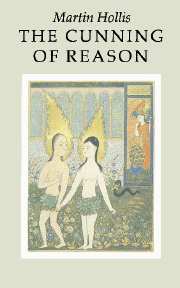Book contents
- Frontmatter
- Contents
- Preface
- 1 The sovereign artificer
- 2 Rational choice
- 3 Norms and institutions
- 4 The Cunning of Reason I: unintended consequences
- 5 Motivation
- 6 External and internal reasons
- 7 Rational Expectations
- 8 Maximising and satisficing
- 9 The Cunning of Reason II: functions and rules
- 10 Reasons and roles
- 11 Rationality and understanding
- 12 The Cunning of Reason III: self and society
- Bibliography
- Index
1 - The sovereign artificer
Published online by Cambridge University Press: 15 December 2009
- Frontmatter
- Contents
- Preface
- 1 The sovereign artificer
- 2 Rational choice
- 3 Norms and institutions
- 4 The Cunning of Reason I: unintended consequences
- 5 Motivation
- 6 External and internal reasons
- 7 Rational Expectations
- 8 Maximising and satisficing
- 9 The Cunning of Reason II: functions and rules
- 10 Reasons and roles
- 11 Rationality and understanding
- 12 The Cunning of Reason III: self and society
- Bibliography
- Index
Summary
God speaks to Adam:
I have given you, Adam, neither a predetermined place nor a particular aspect nor any special prerogatives in order that you may take and possess these through your own decision and choice. The limitations on the nature of other creatures are contained within my prescribed laws. You shall determine your own nature without constraint from any barrier, by means of the freedom to whose power I have entrusted you. I have placed you at the centre of the world so that from that point you might see better what is in the world. I have made you neither heavenly nor earthly, neither mortal nor immortal, so that like a free and sovereign artificer you might mould and fashion yourself into that form you yourself shall have chosen.
These ringing sentences come from the the Oration on the Dignity of Man which Pico della Mirandola wrote in 1484. They capture a Renaissance humanist vision of man as special in the cosmos, and should catch recent social theorists in two minds. On the one hand God places Adam at the centre of the world and makes him his own artificer. That is just right for an individualism grounded on the idea that man is an active subject, who fashions the fabric of the social world. On the other hand God prescribes no constraints from any barrier. That seems to put Adam beyond the pale of every kind of science. However tempting active subjects may be to political theories of liberty, science needs objects.
- Type
- Chapter
- Information
- The Cunning of Reason , pp. 1 - 14Publisher: Cambridge University PressPrint publication year: 1988



